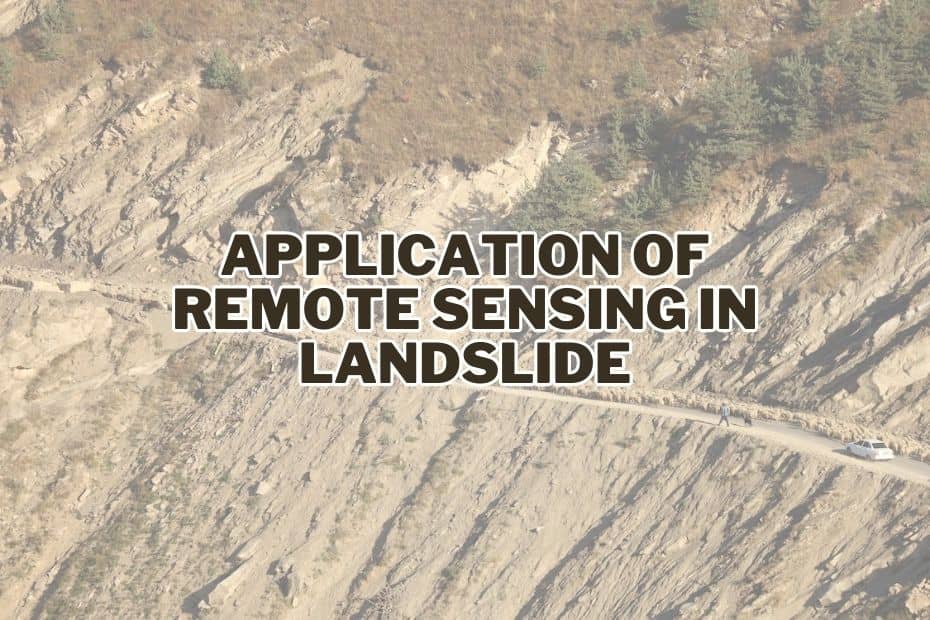Remote sensing, a technology that captures and analyzes data from a distance, has found numerous applications in various fields. One significant area where remote sensing has proven invaluable is in landslide monitoring. Landslides are natural disasters that can cause immense damage to lives and property, and early detection and monitoring play a crucial role in mitigating their impact. In this article, we will explore the application of remote sensing in landslide monitoring.
Remote Sensing technologies enable the detection, monitoring, and assessment of landslide-prone areas. These applications include identifying potential triggers, mapping terrain changes, and evaluating risk factors. With its ability to capture large-scale data and offer real-time information, remote sensing significantly enhances landslide management and mitigation strategies.
Understanding Landslides
Landslides occur when there is a downward and outward movement of rock, soil, or debris on a slope. They can be triggered by various factors such as heavy rainfall, earthquakes, volcanic activity, or human activities like deforestation and construction. Remote sensing can aid in monitoring and predicting landslides, thereby helping in disaster management and prevention.
Application of Remote Sensing In Landslide
The practice of utilizing remote sensing for managing natural disasters like landslides is growing in importance. This technology presents a robust and cost-effective tool for timely detection, mapping, monitoring, and analysis of landslide hazards.
1. Landslide Detection and Mapping
Remote sensing plays a critical role in landslide detection and mapping. Using a variety of sensors and platforms, we can identify and locate landslides, distinguishing them from other geological phenomena. Tools like Synthetic Aperture Radar (SAR) and Light Detection and Ranging (LiDAR) contribute towards creating detailed landslide inventories and mapping landslide-prone areas.
2. Monitoring Ground Movements
One essential aspect of landslide management is monitoring ground movements. Remote sensing technologies provide accurate and regular updates on ground displacement, which can signal an impending landslide. These ground motion maps are essential in identifying risky areas, planning mitigation strategies, and implementing safety measures.
3. Terrain and Elevation Modeling
Accurate terrain and elevation models are crucial for landslide susceptibility mapping and risk assessment. Remote sensing technologies, such as Light Detection and Ranging (LiDAR), provide high-resolution data for generating Digital Elevation Models (DEMs) and Digital Surface Models (DSMs). These models aid in understanding the terrain’s morphology and identifying regions susceptible to landslides.
4. Rainfall and Weather Monitoring
Weather patterns, especially heavy rainfall, significantly influence landslide occurrences. Remote sensing provides real-time meteorological data that helps in forecasting weather conditions and identifying regions at risk of rainfall-induced landslides.
5. Vegetation Monitoring
Vegetation plays a critical role in stabilizing slopes and preventing landslides. Remote sensing techniques allow us to assess vegetation health and coverage, aiding in identifying areas where deforestation or changes in vegetation patterns may increase landslide susceptibility.
6. Risk Assessment and Vulnerability Analysis
Remote sensing assists in evaluating the vulnerability of communities and infrastructure to landslides. By integrating remote sensing data with Geographic Information System (GIS) tools, we can develop comprehensive risk assessment models, aiding authorities in prioritizing mitigation efforts.
7. Emergency Response and Damage Assessment
Post-landslide, remote sensing assists in assessing damage and coordinating emergency response. By analyzing high-resolution images from satellites and drones, responders can locate blocked routes, identify areas in need of immediate assistance, and plan recovery efforts.
8. Landslide Hazard Zonation
Through the application of remote sensing data, scientists can delineate areas according to their potential for landslide occurrence, creating hazard zonation maps. These maps aid in effective land use planning and disaster management.
9. Deformation Monitoring of Structures
Remote sensing technologies, particularly InSAR, can monitor structural deformations caused by ground movements, including landslides. This capability is instrumental in assessing the stability of critical infrastructure, such as buildings, bridges, and dams, in landslide-prone regions.
10. Climate Change Impact Analysis
With climate change impacting weather patterns and intensifying extreme events, the frequency and magnitude of landslides are likely to increase. Remote sensing helps analyze the impact of climate change on landslide occurrences and guides adaptation strategies.
11. Research and Scientific Studies
Researchers widely use remote sensing in scientific studies related to landslides. The high-quality data it provides help in enhancing our understanding of landslides, contributing to advancements in detection, monitoring, prediction, and management practices.
Conclusion
Remote sensing applications offer an integrated, versatile, and efficient approach to landslide management. From early detection to post-disaster assessment, the technology stands as a cornerstone in minimizing the impact of such devastating natural events. As the science evolves, so will our capability to safeguard communities and landscapes from landslide hazards.
FAQs: Application of Remote Sensing In Landslide
What role does remote sensing play in landslide management?
Remote sensing aids in landslide detection, mapping, monitoring ground movements, terrain modeling, rainfall tracking, vegetation monitoring, risk assessment, emergency response, hazard zonation, structural deformation monitoring, and climate change impact analysis.
How does remote sensing assist in landslide detection and mapping?
Remote sensing technologies like Synthetic Aperture Radar (SAR) and Light Detection and Ranging (LiDAR) enable the detection and mapping of landslide-prone areas.
Can remote sensing forecast weather conditions related to landslides?
Yes, remote sensing provides real-time meteorological data, which helps in predicting weather conditions and identifying regions at risk of rainfall-induced landslides.
Can remote sensing help in studying the impact of climate change on landslides?
Yes, remote sensing is an invaluable tool in tracking how shifts in climatic conditions can exacerbate landslide risks.
